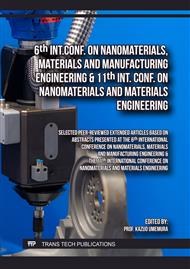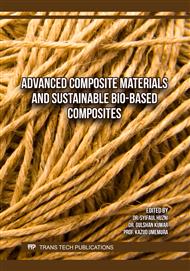[1]
Sarkar, D., Borah, P., Samanta, S., Teyi, N., Chetia, P., & Borah, R. (2023). Tribo-performance of saw dust filled natural fiber–Glass fiber reinforced epoxy composites: Modelling and optimization. Materials Today: Proceedings, 80, 904-910.
DOI: 10.1016/j.matpr.2022.11.326
Google Scholar
[2]
Sarkar, D., Teyi, N., Borah, P., & Chetia, P. (2024). Optimization of wear and friction behaviour of fish scale powder filled natural fibre/glass fibre hybrid epoxy composite in dry sliding condition. Engineering Research Express, 6(4), 045507.
DOI: 10.1088/2631-8695/ad7cc6
Google Scholar
[3]
Sarkar, D., Chetry, D. R., Kumar, R., Borah, P., Samanta, S., & Teyi, N. (2022, June). Study of Dry Sliding Wear Behaviour of Silicon Carbide Filled Glass-Jute Hybrid Epoxy Composite Using RSM and Taguchi Techniques. In Materials Science Forum (Vol. 1060, pp.37-42). Trans Tech Publications Ltd.
DOI: 10.4028/p-a12iqf
Google Scholar
[4]
Sree, M. U., Sudha, S., Reddy, Y. Y., Sahasrarchith, N., & Anand, A. V. (2023, May). Mechanical properties of hybrid composite sandwich structure with sisal and E glass fiber. In AIP Conference Proceedings (Vol. 2492, No. 1). AIP Publishing.
DOI: 10.1063/5.0113271
Google Scholar
[5]
Devendrappa, S. K., Puttegowda, M., & Nagaraju, S. B. (2024). Enhancing wear resistance, mechanical properties of composite materials through sisal and glass fiber reinforcement with epoxy resin and graphite filler. Journal of the Indian Chemical Society, 101(10), 101349.
DOI: 10.1016/j.jics.2024.101349
Google Scholar
[6]
Velmurugan, G., Kumar, G., Chohan, J. S., Sree, S. N., Akash, J., & Deepthi, J. B. (2024). Experimental investigation of mechanical and erosion properties of twill E-glass/sisal fiber reinforced hybrid polymer composite. Materials Today: Proceedings.
DOI: 10.1016/j.matpr.2024.03.032
Google Scholar
[7]
Teyi, N., & Tamang, S. K. (2020). Stress analysis of a flange stiffened FRP composite panel with varying stacking sequence. Key Engineering Materials, 847, 9-14.
DOI: 10.4028/www.scientific.net/kem.847.9
Google Scholar
[8]
Rana, N. K., Teyi, N., & Borah, P. (2023). Stress analysis of laminated graphite fiber reinforced polymer Panel Stiffened joint with 450 fiber orientation using ANSYS. Materials Today: Proceedings, 80, 449-455.
DOI: 10.1016/j.matpr.2022.10.196
Google Scholar
[9]
Ramesh, V., Karthik, K., Cep, R., & Elangovan, M. (2023). Influence of stacking sequence on mechanical properties of basalt/ramie biodegradable hybrid polymer composites. Polymers, 15(4), 985.
DOI: 10.3390/polym15040985
Google Scholar
[10]
Massar, L., Sarkar, R., Komo, N., & Teyi, N. (2024). Fabrication and Water Absorption Testing of Banana Fiber-Reinforced Composite. New Materials, Processing and Manufacturability: Fabrication and Processing of Advanced Materials, 351.
DOI: 10.1002/9781394212736.ch19
Google Scholar
[11]
Kchaou, M., Arul, S. J., Athijayamani, A., Adhikary, P., Murugan, S., Aldawood, F. K., & Abualkhair, H. F. (2023). Water absorption and mechanical behaviour of green fibres and particles acting as reinforced hybrid composite materials. Materials Science-Poland, 41(4), 132-143.
DOI: 10.2478/msp-2023-0051
Google Scholar
[12]
Mohammed, M., Jawad, A. J. A. M., Mohammed, A. M., Oleiwi, J. K., Adam, T., Osman, A. F., ... & Jaafar, M. (2023). Challenges and advancement in water absorption of natural fiber-reinforced polymer composites. Polymer Testing, 124, 108083.
DOI: 10.1016/j.polymertesting.2023.108083
Google Scholar



